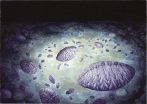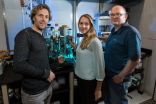(Press-News.org) Scientists from the University of Leeds have uncovered further evidence that the protective buffers at the ends of chromosomes - known as telomeres - are fundamental to the understanding of the deadliest form of skin cancer, melanoma.
A team of international researchers, co-led by Dr Mark Iles from the University's School of Medicine and St James's University Hospital in Leeds, has uncovered five new common genetic risk factors for melanoma. They have also confirmed two others previously suspected to be risk factors.
Dr Iles said: "This research establishes further the important role that telomeres, which prevent damage to the ends of chromosomes and stop them from fusing together, play in the development of melanoma.
"A previous study last year established the importance of telomeres in melanoma - this research builds on that evidence."
Working with colleagues from the QIMR Berghofer Medical Research Institute in Brisbane and others worldwide, Dr Iles and his team collected data from 11 studies of 15,990 melanoma patients and 26,409 healthy volunteers.
In addition to the role of telomeres, the researchers also found more evidence that skin pigmentation is a key genetic determinant of melanoma.
Dr Iles added: "We now know of 20 common genetic risk factors and 12 of these are clearly related to either telomere length, pigmentation or the number of moles an individual has. These last two factors are particularly important, because they are long-established as indicators of risk for melanoma. This reinforces the message that anyone with pale skin and many moles should take extra care when in the sun."
There was also evidence that genes involved in the repair of DNA had a role to play in the development of melanoma.
Malignant melanoma is the fifth most common cancer in the UK with some 12,800 new cases and about 2,200 deaths each year.*
Dr Matthew Law, from QIMR Berghofer, said the international collaboration is now preparing for an even larger study which is expected to find more markers of risk.
"At the same time we need to start working out how these genetic variations work, in the hope we will find a gene that is a drug target to improve treatment for patients," Dr Law said.
Dr Kat Arney, science information manager at Cancer Research UK, said: "Each person's chances of developing cancer are due to a complex interplay between genes, lifestyle and environment. Research like this is vital for teasing out the role of each of these factors.
"It's a good idea for everyone to enjoy the sun safely because most skin cancers are linked to too much UV from the sun or sunbeds. We all need some sun for healthy bones but when the sun is strong, spend time in the shade, cover up with clothing and a wide-brimmed hat, and use sunscreen for the parts you can't cover with clothes."
INFORMATION:
The research was funded by Cancer Research UK and the US Institutes of Health and published in the journal Nature Genetics.
Further information
Dr Mark Iles is available for interview. Contact Ben Jones in the University of Leeds press office on 0113 343 4031 or email B.P.Jones@leeds.ac.uk
Please note that Dr Mark Iles will be available for interview from Monday morning, August 3.
A copy of the paper, "Genome-wide meta-analysis identifies five new susceptibility loci for cutaneous malignant melanoma", by Law et al, is available from the Press Office.
*Source: Cancer Research UK
University of Leeds
The University of Leeds is one of the largest higher education institutions in the UK, with more than 31,000 students from 147 different countries, and a member of the Russell Group research-intensive universities.
We are a top 10 university for research and impact power in the UK, according to the 2014 Research Excellence Framework, and positioned as one of the top 100 best universities in the world in the 2014 QS World University Rankings. http://www.leeds.ac.uk
Researchers led by the University of Cambridge have found the earliest example of reproduction in a complex organism. Their new study has found that some organisms known as rangeomorphs, which lived 565 million years ago, reproduced by taking a joint approach: they first sent out an 'advance party' to settle in a new area, followed by rapid colonisation of the new neighbourhood. The results, reported today in the journal Nature, could aid in revealing the origins of our modern marine environment.
Using statistical techniques to assess the distribution of populations ...
High-dose vitamin D supplementation in postmenopausal women was not associated with beneficial effects on bone mineral density, muscle function, muscle mass or falls, according to the results of a randomized clinical trial published online by JAMA Internal Medicine.
Low levels of vitamin D contribute to osteoporosis because of decreased total fractional calcium absorption (TFCA) and nearly half of postmenopausal women sustain an osteoporotic fracture. However, experts disagree on the optimal vitamin D level for skeletal health. Some experts contend that optimal serum ...
A recently discovered family of small RNA molecules, some of which have been implicated in cancer progression, has just gotten much larger thanks to a new RNA sequencing technique developed by researchers at UC Santa Cruz.
The technique, described in a paper published August 3 in Nature Methods, provides sensitive detection of small RNAs that are chemically modified (methylated) after being transcribed from the genome. The researchers used the technique to reveal an abundance of modified fragments derived from transfer RNA molecules in both yeast cells and human cells.
"Transfer ...
Skeletal muscle is one of the most abundant tissue types in the human body, but has proven difficult to produce in large quantities in the lab. Unlike other cell types, such as heart cells, neurons and cells found in the gut, previous attempts to efficiently and accurately derive muscle cells from pre-cursor cells or culture have not been fruitful. In a new study published this week in Nature Biotechnology, investigators from Brigham and Women's Hospital (BWH) report that by identifying and mimicking important developmental cues, they have been able to drive cells to grow ...
LA JOLLA--T cells are the guardians of our bodies: they constantly search for harmful invaders and diseased cells, ready to swarm and kill off any threats. A better understanding of these watchful sentries could allow scientists to boost the immune response against evasive dangers (e.g., cancer or infections), or to silence it when it mistakenly attacks the body itself (e.g., autoimmune disorders or allergies).
Now, scientists at the Salk Institute have discovered that T cell triggering relies on a dynamic protein network at the cell surface, as reported in August 3, ...
New brain research has mapped a key trouble spot likely to contribute to intellectual disability in Down syndrome. In a paper published in Nature Neuroscience [3 Aug], scientists from the University of Bristol and UCL suggest the findings could be used to inform future therapies which normalise the function of disrupted brain networks in the condition.
Down syndrome is the most common genetic cause of intellectual disability, and is triggered by an extra copy of chromosome 21. These findings shed new light on precisely which part of the brain's vast neural network contribute ...
Greenhouse-gas emissions from human activities do not only cause rapid warming of the seas, but also ocean acidification at an unprecedented rate. Artificial carbon dioxide removal (CDR) from the atmosphere has been proposed to reduce both risks to marine life. A new study based on computer calculations now shows that this strategy would not work if applied too late. CDR cannot compensate for soaring business-as-usual emissions throughout the century and beyond, even if the atmospheric carbon dioxide (CO2) concentration would be restored to pre-industrial levels at some ...
NEW YORK, NY (August 3, 2015) - Scientists at The New York Stem Cell Foundation (NYSCF) Research Institute successfully designed a revolutionary, high-throughput, robotic platform that automates and standardizes the process of transforming patient samples into stem cells. This unique platform, the NYSCF Global Stem Cell ArrayTM, for the first time gives researchers the scale to look at diverse populations to better understand the underlying causes of disease and create new individually tailored treatments, enabling precision medicine in patient care.
A paper published ...
When it comes to making decisions involving others, the impression we have of their character weighs more heavily than do our assessments of how they can benefit us, a team of New York University researchers has found.
"When we learn and make decisions about people, we don't simply look at the positive or negative outcomes they bring to us--such as whether they gave us a loan or helped us move," explains Leor Hackel, a doctoral candidate in NYU's Department of Psychology and the study's lead author. "Instead, we often look beyond concrete outcomes to form trait impressions, ...
Our brains are constantly barraged with sensory information, but have an amazing ability to filter out just what they need to understand what's going on around us. For instance, if you stand perfectly still in a room, and that room rotates around you, it's terrifying. But stand still in a room and turn your eyes, and the same visual input feels perfectly normal. That's thanks to a complex process in our brain that tell us when and how to pay attention to sensory input. Specifically, we ignore visual input caused by our own eye movements.
Now, researchers at The Rockefeller ...


